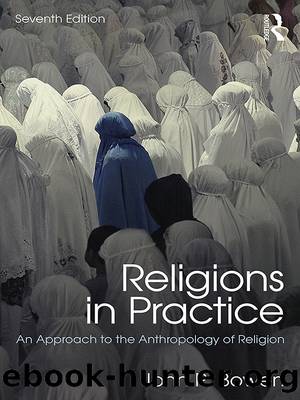Religions in Practice by Bowen John R

Author:Bowen, John R. [Bowen, John R.]
Language: eng
Format: epub
Publisher: Taylor & Francis Ltd
Evidence and confessions
Everyone in Salem accepted that witches did exist. Satanâs struggle for the souls of people was evident in the world, and misfortune always had a moral tinge to it. As the historian Perry Miller has written, Puritanism had no room for failure. When failure came, it was due to the work of Satan in the world, and among his favorite vehicles were witches.
What was the evidence of witchcraft? According to the canons of evidence of the day, several kinds were admissible (Boyer and Nissenbaum 1974; Demos 1982). One was empirical evidence, which included behavioral traits: These could be positive, such as great physical strength, or negative, such as the inability to recite the Lordâs Prayer all the way through. Second was the category called âAnger followed by Mischief,â that is, in cases when after a quarrel or even a sharp look, someone was stricken with illness. This evidence was eventually rejected because of the difficulty of ascertaining the empirical links between the âangerâ and the âmischief.â Finally and most dramatically, there was Spectral Evidence â in this case, when the afflicted girls saw figures of the accused coming toward them and harming them. This evidence could, of course, be produced at a momentâs notice. Mary Warren, one of the girls, tried to recant her own accusations against previous witches when the other girls accused her master, John Proctor. The others responded to her defection by immediately seeing specters around her. At this threat, she retracted her recantation and returned to their side. But when ârespectableâ townspeople began to be accused, some of the ministers remembered that Satan was capable of creating specters and images to mislead the God-fearing, and at that point Spectral Evidence began to be doubted publicly.
Of course, many people confessed before the case could come to trial. Those who did confess were released. From the perspective of a modern trial court, this course of action seems very odd. Why release confessed criminals and hang those who insisted on their innocence? But from the perspective of comparative witchcraft studies, this is what we would expect. As in the Azande case, the confession purged the community of tensions and, in this instance, of the deep guilt it felt for straying from the righteous path. As with the blowing out of water among the Azande, the confession gives a language for conflicts, the language of Satan and witchcraft.
Here is another way the Salem events went wrong. The first three women to be accused had confessed but after that confessions virtually ceased. Why? The historians Paul Boyer and Stephen Nissenbaum (1974) argue that a cultural change was just then occurring in New England, one that valued individual conscience and pride, such that many people were no longer willing to confess for the sake of community. But the logic of accusation and confession had not quite caught up with their new sense of obligation and responsibility. From this point of view, the events in Salem are a terrible result of
Download
This site does not store any files on its server. We only index and link to content provided by other sites. Please contact the content providers to delete copyright contents if any and email us, we'll remove relevant links or contents immediately.
The Lost Art of Listening by Michael P. Nichols(7169)
Why I Am Not A Calvinist by Dr. Peter S. Ruckman(4048)
The Rosicrucians by Christopher McIntosh(3373)
Wicca: a guide for the solitary practitioner by Scott Cunningham(3045)
Signature in the Cell: DNA and the Evidence for Intelligent Design by Stephen C. Meyer(2879)
Real Sex by Lauren F. Winner(2869)
The Holy Spirit by Billy Graham(2779)
To Light a Sacred Flame by Silver RavenWolf(2679)
The End of Faith by Sam Harris(2637)
The Gnostic Gospels by Pagels Elaine(2400)
Waking Up by Sam Harris(2332)
Nine Parts of Desire by Geraldine Brooks(2282)
Jesus by Paul Johnson(2230)
Devil, The by Almond Philip C(2206)
The God delusion by Richard Dawkins(2191)
Heavens on Earth by Michael Shermer(2190)
Kundalini by Gopi Krishna(2094)
Chosen by God by R. C. Sproul(2056)
The Nature of Consciousness by Rupert Spira(1983)
